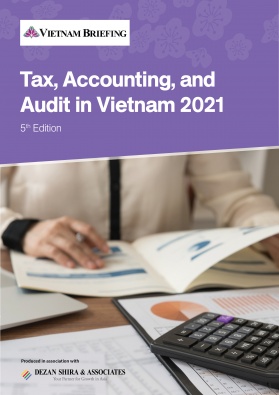The Global Minimum Tax and Potential Implications for Vietnam
On October 8, 2021, the Organization for Economic Cooperation and Development (OECD) announced a major breakthrough on a global minimum corporate tax rate of 15 percent. The landmark deal was signed by 136 countries, including Vietnam, representing 90 percent of global GDP. These include jurisdictions well known for their low corporate tax rates, such as Singapore, Hong Kong, Ireland, and others.
What is the goal of the global minimum corporate tax rate?
Broadly speaking, the global minimum tax agreement (the “Agreement”) seeks to modernize taxation for a globalized and digitalized economy. The Agreement has two separate but related goals: reallocate tax rights distribution to where companies actually carry out their business activities and establish a global minimum corporate tax rate to deter the use of offshore tax havens.
With the spread of digital services, many companies are able to carry out significant amounts of business in areas where they have little to no staff or physical presence. By expanding taxation rights on where companies carry out their business rather than where they are based, countries hope to better tax digital services that can easily cross borders. This also applies to other sources of income, such as intellectual property royalties, many of which multinationals collect in tax havens.
Putting more emphasis on actual business activities also aims to reduce corporate tax evasion and the utility of tax havens. This is in tandem with the global minimum corporate tax, which seeks to eliminate the practice of companies registering their headquarters in tax shelters where they conduct little actual business, as well as the incentive for countries to compete with one another on low tax rates.
What’s in the agreement?
The Agreement contains two pillars delineating how its two main goals will be carried out in practice.
Pillar One
The first pillar establishes a fairer distribution between countries of the profits and taxing rights of large multinationals.
In other words, highly profitable multinationals will need to re-allocate some of their taxation to where their business activities are generating profits rather than their home countries, even if they do not have a physical presence there. This is known as ‘market jurisdictions’ and seeks to align the market value of goods and services with where they are consumed rather than produced.
Multinationals with global sales over EUR 20 billion (US$873 billion) and a pre-tax profit margin of above 10 percent will see 25 percent of their profit beyond the 10 percent threshold reallocated to market jurisdictions. Businesses would need to derive at least 1 million euros from that country (for smaller economies, with GDP less than 40 billion euros, it would be 250,000 euros).
The OECD also announced that an agreement had been reached for the removal of all existing digital services taxes and similar unilateral measures.
Pillar Two
The second pillar establishes a global minimum corporate tax rate of 15 percent. It does not stop countries from engaging in tax competition but sets limits on their ability to do so as a means to prevent a “race to the bottom”. The new minimum tax rate would apply to multinationals with annual revenues of more than 750 million euros (US$866 million). The OECD projects this would generate around US$150 billion in additional global tax revenue every year. Moreover, the OECD expects that it will lead to a more stable international tax system, as countries will not change their tax rates as frequently or to such large extents.
How would the global minimum tax work?
The basic idea is simple: countries would legislate a global minimum corporate tax rate of at least 15 percent for large companies, those with annual revenues over 750 billion euros (US$1.2 trillion). Then, if companies have earnings that go untaxed or lightly taxed in one of the world’s tax havens, their home country would impose a top-up tax that would bring the rate to 15 percent.
This would make it pointless for a company to use tax havens since taxes avoided in the haven would be collected at home. For the same reason, it means the minimum rate would still take effect even if individual tax havens don’t participate.
Jeff Goldstein, former Under Secretary of the Treasury for Domestic Finance in the US explained in a paper for the think tank Atlantic Council as below:
“Assume Country A has a corporate tax rate of 20 percent and Country B has a corporate tax rate of 11 percent. The global minimum tax rate is 15 percent, and Company X is headquartered in Country A but reports income in Country B. Country A would ‘top-up’ the taxes paid on profits earned by Company X in Country B in a manner equal to the percentage-point difference between Country B’s rate of 11 percent and the global minimum of 15 percent (e.g., Company X would pay in taxes an additional 4 percent of profits reported in Country B). This approach would set a floor on the collection of global tax revenue and help alter corporate incentives because companies would know that profits shifted to tax havens would face incremental taxation”.
Transfer pricing considerations
Pillar one also involves a portion of residual profit being reallocated to market jurisdictions using formulary apportionment concepts, which were rejected by OECD members only a few years ago.
This allocation of profits may not be the same as the allocation of profits currently under the arm’s length principle (ALP). They highlight that multinational groups exist for the purpose of generating profit by internalizing transactions that would be more costly if conducted with unrelated parties. Critics also argue that the application of the principle is complex and potentially subject to manipulation, giving companies the possibility of locating their profit in low-tax countries.
Of the various alternatives to the ALP proposed by its critics, the one that most often emerges is a system based on apportionment, where the taxable profit of a multinational group would be allocated to its constituent entities based on predetermined formulas and factors (often sales, employees and assets — the so-called formulary apportionment or “FA”).
According to its proponents, the use of an FA system would reduce compliance costs for tax administrations and taxpayers alike, as it would only be necessary to compute the multinational group’s global profit and the value of factors included in the formula. Therefore, FA would give all involved parties more certainty about the amount of taxes to be paid on international business activities.
Implications for Vietnam
The CIT rate in Vietnam is 20 percent, above the minimum rate. However, Vietnam offers certain types of tax incentives such as four years of tax exemption, nine years of 50 percent tax reduction, and 10 percent preferential tax rate for 15 years to companies/projects investing in encouraged sectors and areas e.g. scientific research and technology development; software production; manufacturing composite materials, light construction materials; clean energy, etc. If the minimum global tax rate is applied, then any tax savings enjoyed by qualified multinationals in Vietnam will be lost.
Secondly, Vietnam will be able to tax large (including tech) companies without worrying about retaliation from the governments of developed countries.
Recently the Ministry of Finance (MoF) has issued a circular on tax administration (Circular 80/2021/TT-BTC) that would compel tech giants like Google, Facebook, Amazon, and Netflix to pay taxes. Furthermore, the Ministry of Information and Communications (MIC) is also proposing a draft decree of the amendments to Decree No. 181/2013/NDCP to amend some Articles in the Law on Advertising (Draft Decree), which imposes tax obligations on the cross-border service providers.
Accordingly, foreign-based enterprises who do not have a commercial presence in Vietnam but provide goods or services to Vietnamese customers shall be considered as permanent establishments (PEs) in Vietnam and subject to 2 percent to 5 percent of value-added tax and 0.1 percent to 10 percent of CIT on the revenue generated in Vietnam. PEs may declare and pay tax by themselves or through tax agencies, banks, and non-bank financial institutions, or Vietnamese customers.
In case the PEs do not declare and pay tax:
- If the Vietnamese customer is a business or organization it shall declare and pay tax on behalf of the PE.
If the Vietnamese customer is an individual:
(i) the commercial banks or non-bank financial institutions are obliged to withhold tax from the payment to the PEs;
(ii) the General Department of Taxation shall make a “blacklist” (including name, website) of the PEs who have not registered, declared, and paid taxes and send this blacklist to commercial banks and non-bank financial institutions to identify non-compliant PEs and withhold tax from the payment to the PEs; and
(iii) if the payment is made via cards or other forms that the commercial banks or non-bank financial institutions are unable to withhold tax then the commercial banks or non-bank financial institutions are obliged to track the payments and report to the General Department of Taxation.
Third is the risk of double taxation.
Most large tech companies are based in the US. Vietnam and the US signed the agreement for the Avoidance of Double Taxation and The Prevention of Fiscal Evasion with respect to Taxes on Income (DTA) on July 7, 2015. However, the DTA is yet to be ratified. As a result, the revenue generated in Vietnam of US-based companies may be taxed in both Vietnam and the US.
Lastly, though Vietnam is not a member of OECD, transfer pricing is a major concern of the Vietnam tax authority. In fact, Vietnam lawmakers used to adopt OECD’s concepts and principles on transfer pricing into its laws e.g. Decree No. 132/2020/ND-CP dated November 2020 providing tax administration applicable to enterprises having related party transactions (Decree 132). Authorities adopted the principle of a three-tiered transfer pricing documentation approach to collect more tax-related information on the business operations of MNCs. It is the principle set out in BEPS Action 13 of OECD.
Therefore, it would be likely that Vietnam lawmakers and tax authorities may revise their laws on transfer pricing to be in line with OECD’s new approach on transfer pricing and international practice.
About Us
Vietnam Briefing is produced by Dezan Shira & Associates. The firm assists foreign investors throughout Asia from offices across the world, including in Hanoi, Ho Chi Minh City, and Da Nang. Readers may write to vietnam@dezshira.com for more support on doing business in Vietnam.
We also maintain offices or have alliance partners assisting foreign investors in Indonesia, India, Singapore, The Philippines, Malaysia, Thailand, Italy, Germany, and the United States, in addition to practices in Bangladesh and Russia.
- Previous Article Warum Sie in Vietnams E-Commerce-Branche investieren sollten
- Next Article Vietnam Issues Decision 29 on Special Investment Incentives






























